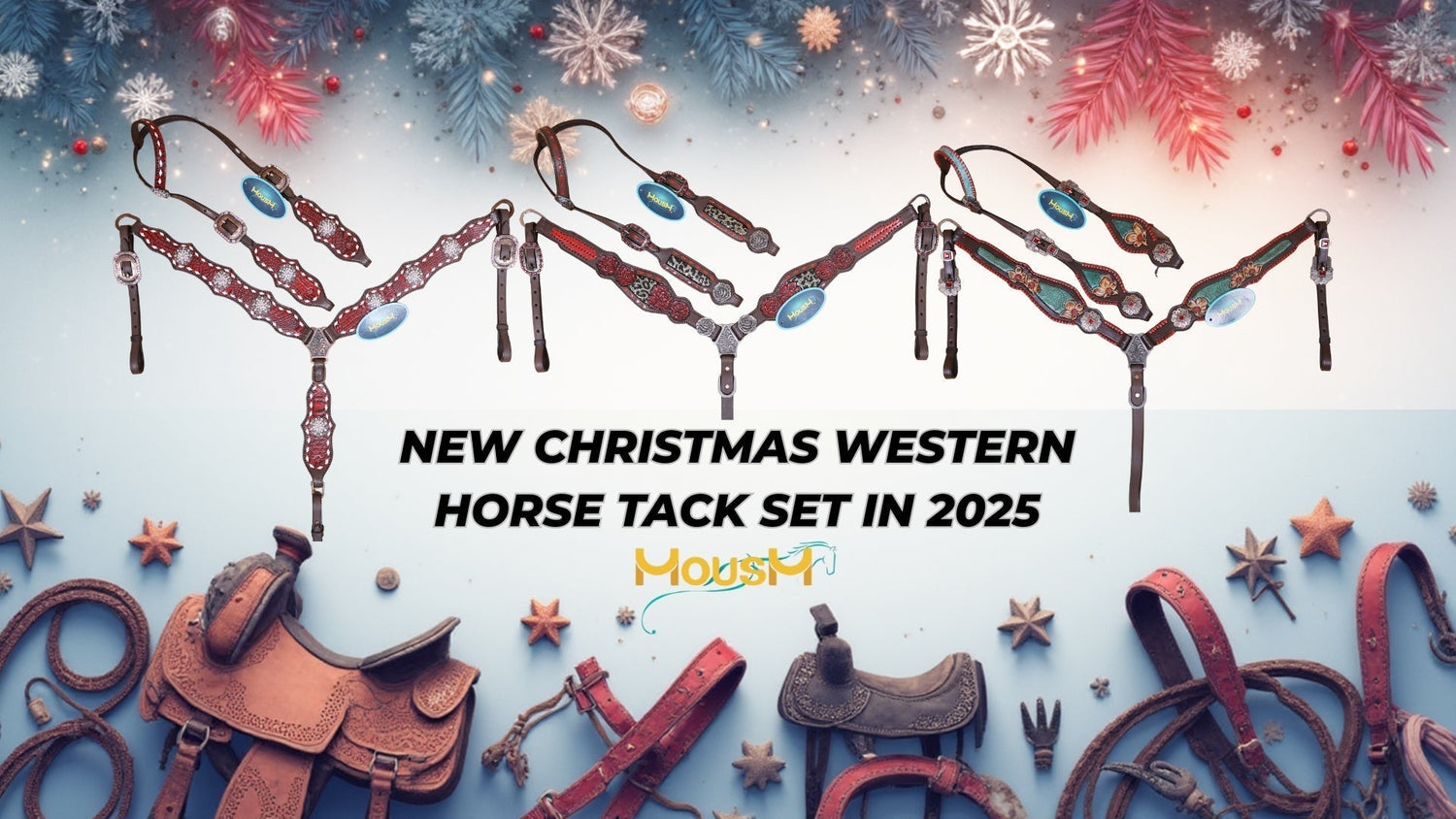The Western headstall, also known as headgear, which plays the crucial role in controlling a horse's movement. A headstall is an essential piece of tack that sits over the horse's head, connecting to the cheekpiece on both sides by holding the bit in place. The primary function of the headstall is to hold the bit securely in place within the horse's mouth, allowing the rider to communicate through gentle rein pressure. A properly fitted headstall ensures clear communication without causing discomfort or distraction to the horse. Western headstalls come in various styles, such as browband, one ear, and two ear designs, each offering a unique fit and aesthetic depending on the riding discipline.
A horse-friendly western headstall is essential for your horse’s comfort, communication, and overall well-being. A well-fitted, thoughtfully designed headstall ensures even pressure distribution across sensitive areas like the poll, cheeks, and ears, preventing chafing, pinching, or tension that can lead to resistance or behavioral issues. When your horse is comfortable, they're more likely to stay focused, respond softly to cues, and perform reliably whether you're on the trail or in the arena. On the flip side, an ill-fitting or harsh headstall can create discomfort that compromises not only your horse’s performance but also your safety in the saddle. Investing in a quality, horse-friendly headstall supports clear communication, builds trust, and promotes a better riding experience for both horse and rider.
In this blog, we’ll go over the key features of a Western headstall that make it horse-friendly.
A. Proper Fit
1. Placing the Headstall
Firstly, approach the horse calmly with soft hands, place the crownpiece over the horse's head gently, lift the crownpiece behind the ears, and hold the headstall holding the bit and slide the bit on the horse's mouth gently.
2. Adjusting the Cheekpiece
After the headstall is in place, check the position of the bit in the horse’s mouth. It should rest gently in the corners of the mouth, creating 1–2 soft wrinkles. If there are too many wrinkles or none at all, adjust the cheek pieces accordingly. Both sides must be adjusted evenly to keep the bit centered. Uneven adjustments can lead to twisting or discomfort, which can affect your horse’s performance and responsiveness.
3. Fitting the Browband or Ear Loops
Next, ensure that the browband or ear loops are positioned correctly. A browband should lie flat across the horse’s forehead without pinching or pulling. For one-ear or two-ear headstalls, the loops should rest just behind the ears without putting pressure on the base of the ears. The goal is a snug yet comfortable fit that holds the headstall in place while allowing the horse to move its ears freely.
4. Throatlatch Adjustment
If your headstall includes a throatlatch, adjust it last. The throatlatch should be secure enough to prevent the headstall from slipping off, but not so tight that it restricts movement or breathing. A good rule of thumb is to allow space for 3–4 fingers between the throatlatch and the horse’s throat. This ensures both security and comfort during riding.
Explore Our Western Headstall and Breast Collar Set
B. Comfortable Materials
A horse-friendly headstall starts with the right materials, ones that feel good against your horse’s skin and hold up to regular use without causing irritation. The headstall comes with various materials, including synthetic, leather, and biothane, but leather is the most durable among these materials. A good material has good padding that reduces chafing and skin irritation.
1. Leather Quality
When it comes to comfort, the leather your headstall is made from matters more than you might think. Soft, flexible leather molds to your horse’s head and moves with them, which helps prevent rubbing or chafing, especially behind the ears and along the cheeks. Stiff or cheap leather can feel harsh and cause discomfort, especially on longer rides or in hot weather. If the leather feels good in your hands, it’s more likely to feel good on your horse, too.
2. Stitching and Seams
It’s easy to overlook the stitching, but your horse will feel it if it’s rough. Quality headstalls have smooth, even stitching that lays flat and doesn’t dig into the skin. Unfinished or bulky seams can irritate over time, especially in areas where the leather moves with the horse’s head. Clean stitching and rolled or finished edges help keep things comfortable and prevent sore spots from developing.
3. Hardware
The metal parts on a headstall—like buckles, bit loops, and conchos—should be smooth and rust-free. Sharp edges or rough spots can pinch or press into your horse’s face, which is uncomfortable and distracting for them. Rounded buckles and quality hardware (usually stainless steel or brass) are not only safer but also more durable. Good hardware helps the headstall stay in place without pulling or shifting, making the ride more pleasant for your horse.
C. Gentle Design Features
A horse-friendly Western headstall should be as unobtrusive as possible. Here are the design elements that help keep it comfortable:
-
Padding (if used): Some headstalls include padding at the poll or browband. While not always necessary, a bit of cushion can make a big difference for horses with sensitive areas, thin skin, or past pressure point issues.
-
Lightweight Construction: Heavier doesn’t mean better. A lighter headstall helps reduce pressure on the poll and ears, especially for long rides or sensitive horses. Look for balanced designs that stay secure without adding bulk.
-
Clean Edges: Rolled or rounded leather edges are far less likely to rub or cause sores than flat, sharp cuts. Smooth transitions—especially around the ears and cheeks keep your horse focused and comfortable, not distracted by discomfort.
D. Adjust Headstall Equipment
A good Western headstall should stay in place without interfering with the horse’s natural movement or causing pressure in the wrong places. Security and comfort go hand in hand:
-
Throatlatch Fit: The throatlatch should be snug enough to keep the headstall from shifting, but never tight. A general rule: you should be able to fit about three fingers between the throatlatch and the horse’s jaw. Too tight, and it can restrict breathing or cause discomfort during rein pressure or head movement.
-
Browband Placement: A properly placed browband sits flat across the forehead without pressing into the ears or sliding too close to the eyes. If it's too short or too low, it can pinch at the base of the ears, one of the most sensitive areas on the horse's head.
-
Bit Attachment Stability: The headstall should hold the bit evenly on both sides without pulling it up too high or letting it sag. Uneven or unstable bit placement can create pressure points in the mouth and confuse the horse’s communication with the rider.
E. Ease of Use for the Rider
While the horse’s comfort comes first, a headstall that’s frustrating to use won’t do either of you any favors. Rider-friendly features make daily tacking quicker, safer, and more consistent:
-
Quick Adjustments: Look for buckles, Chicago screws, or snaps that are easy to handle—even with gloves on—but still secure enough to hold their setting. Adjustments should be smooth and precise, without slipping over time or requiring excessive force.
-
Durability: A good headstall stands up to regular use without becoming stiff, cracked, or stretched out. High-quality leather or sturdy synthetics will hold their shape and function over time, which means fewer replacements and less fiddling with tack right before a ride.
F. Cleanliness and Maintenance
A horse-friendly headstall should also be rider-friendly when it comes to care. Tack that’s easy to maintain stays safer, lasts longer, and is more pleasant for both horse and handler.
-
Easy to Clean: Choose materials that wipe down easily with a damp cloth or respond well to light conditioning. Smooth leather, quality synthetics, and minimal tooling tend to be quicker to clean and less likely to trap sweat, dust, or grime.
-
Low Maintenance Requirements: In hot, humid, or dusty conditions, tack can break down fast if it’s not built to handle the elements. Look for headstalls that resist mildew, sun damage, and cracking—especially if you ride often or store tack in a less-than-ideal environment.
A horse-friendly Western headstall does more than hold a bit in place — it supports clear communication, prevents discomfort, and allows your horse to perform at their best. The right headstall fits well, feels good, and stays secure without being restrictive. Always watch your horse for signs of discomfort, like head tossing, rubbing, or resistance during bridling. These small signals are often the first clues that something isn’t quite right. A little attention to fit and design goes a long way toward keeping your horse happy and willing under the bridle.
Why MOUSM?
At MOUSM, you’ll discover a wide range of equestrian products like: Headstall and Breast Collar Sets, Saddles, Wither Straps, Bronc Halters, Saddle Pads, Reins, Bosals, Tie-Downs, Home Décor, Fashion Accessories, All Types Of Bags (From Handbags To Backpacks), and Dining Products. Handcrafted from genuine Argentina cowhide leather, meticulously handcrafted by our skilled artisans. Each design is a testament to exceptional craftsmanship, featuring intricate hand-tooling, stunning acid wash effects, and eye-catching stonework.
Equipped with premium-quality studs, sparkling stones, and elegant conchos, these products are built with antique copper, nickel, and brass hardware to offer both durability and long-lasting performance. Their sturdy construction ensures they can handle the rigors of Western riding while maintaining their stylish appeal.
Perfect for Western riding, rodeo events, equestrian shows, and everyday wear, MOUSM pieces not only complement your gear with confidence but also add a distinctive and fashionable flair to your collection. Whether you’re in the arena or on the trail, these accessories combine functionality with stunning design, reflecting your passion for riding and your appreciation for quality craftsmanship.













